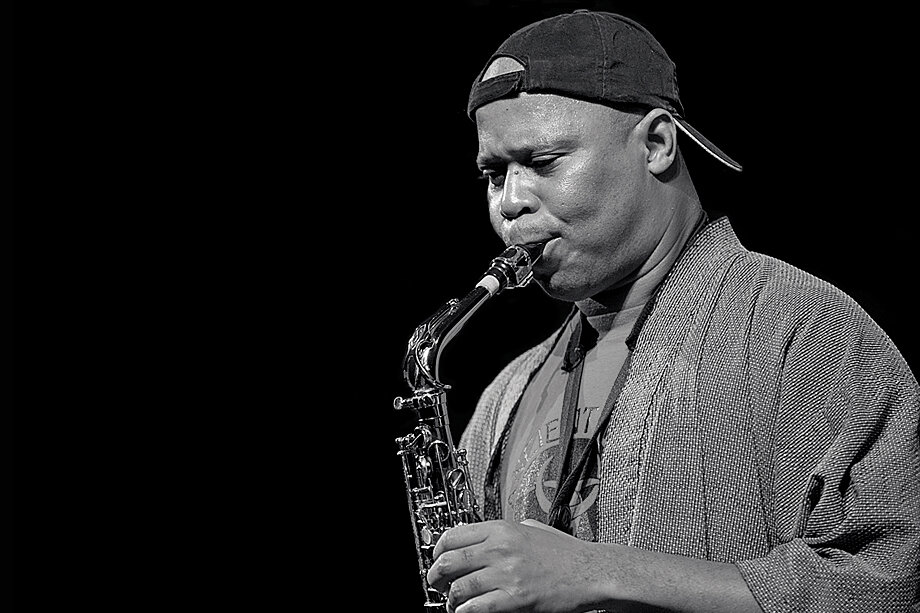Steve Coleman Presents
 To call Steve Coleman "influential" is an understatement. Vijay Iyer, one of the many groundbreaking composer-performers who began their careers apprenticing with Steve, says, “To me, Steve’s as important as Coltrane. He has contributed an equal amount to the history of the music. He deserves to be placed in the pantheon of pioneering artists.”But the scope of Steve's influence isn't limited to his collaborators. He's been presenting weekly workshops at The Jazz Gallery almost every season since the fall of 2004, where anyone with a thirst for knowledge can go to absorb the infinitude he has to offer.On March 8th, we'll be bringing this series uptown in collaboration with our friends at Symphony Space. The Jazz Gallery Uptown: Steve Coleman Presents, A Musical Salon will expose a new neighborhood to Steve's ideas and approaches. For those of you downtown, we'll also begin the Spring season of "Steve Coleman Presents" at The Jazz Gallery next Monday.Never been to one of Steve's workshops? Michael J. West provides a great account in the 2010 issue of JazzTimes:
To call Steve Coleman "influential" is an understatement. Vijay Iyer, one of the many groundbreaking composer-performers who began their careers apprenticing with Steve, says, “To me, Steve’s as important as Coltrane. He has contributed an equal amount to the history of the music. He deserves to be placed in the pantheon of pioneering artists.”But the scope of Steve's influence isn't limited to his collaborators. He's been presenting weekly workshops at The Jazz Gallery almost every season since the fall of 2004, where anyone with a thirst for knowledge can go to absorb the infinitude he has to offer.On March 8th, we'll be bringing this series uptown in collaboration with our friends at Symphony Space. The Jazz Gallery Uptown: Steve Coleman Presents, A Musical Salon will expose a new neighborhood to Steve's ideas and approaches. For those of you downtown, we'll also begin the Spring season of "Steve Coleman Presents" at The Jazz Gallery next Monday.Never been to one of Steve's workshops? Michael J. West provides a great account in the 2010 issue of JazzTimes:
The audience at the Jazz Gallery is under Steve Coleman’s spell. The alto saxophonist, casually dressed in jeans and a backwards baseball cap, sits center stage at the scruffy upstairs club in New York’s SoHo district, leading two of his band members—pianist David Virelles and guitarist Miles Okazaki—through alien-sounding renditions of Jerome Kern’s “All the Things You Are.” The people in the club’s cramped chairs sit in rapt attention, following Coleman’s urgings to clap and sing along with the musicians. Then something unusual happens: Coleman calls one young spectator up to sit with Virelles at the piano, and encourages others to stand onstage behind him and watch.This is Coleman’s gig, but it isn’t a concert. On a Monday night in March, he’s conducting his weekly master class and workshop, “Steve Coleman Presents,” for musicians of all instruments and skill levels. Coleman has spent the evening discussing negative chords, a system of his own design in which chords are built by stacking notes downward, not upward, from the root. He and his musicians first re-harmonize the changes on “All the Things You Are,” then reconstruct the tune itself using the same concept. “You’re gonna work out the bridge,” he tells the kid he’s brought onto the bandstand, and for the next hour they deconstruct the standard’s B-section note by note, looking to retain the compositional structure but turn it upside down as the remainder of the class—about 20 people, mostly young, some with instruments—looks on.“What you’re really doing with this is to alter your perspective,” he explains as the kid picks away at the keys. “You’re just looking at the same thing from a different angle, holding up a magnifying glass to see why things work and why they don’t. And you don’t have to stop tonight; you can keep doing it, because it presents situations you’ve never been in before and possibilities you’ve never even thought of.”[Continue reading here.]
We'd like to point out that Steve's own website is an incredible resource, with several scores and essays - as well as almost two dozen albums - available for free download. The author also recommends this feature in The Wall Street Journal, as well as this extensive 2008 interview via Innerviews.